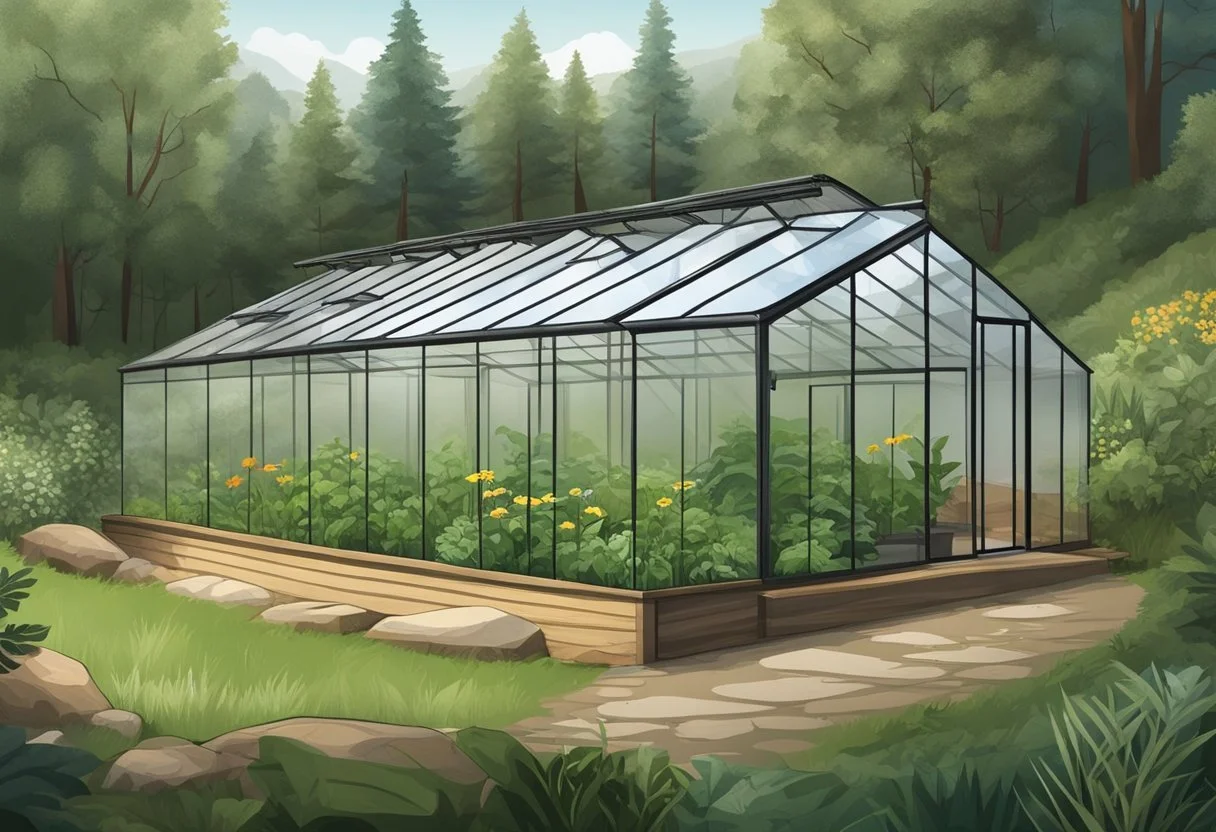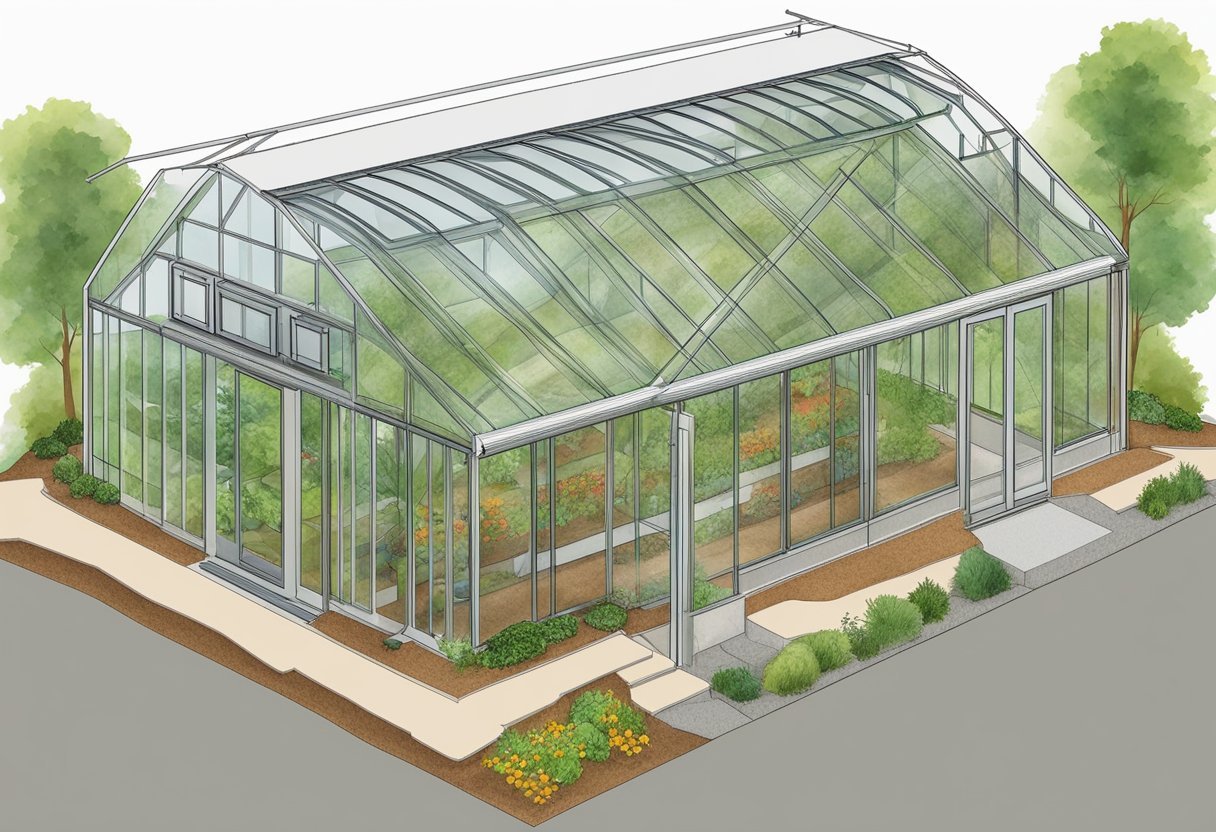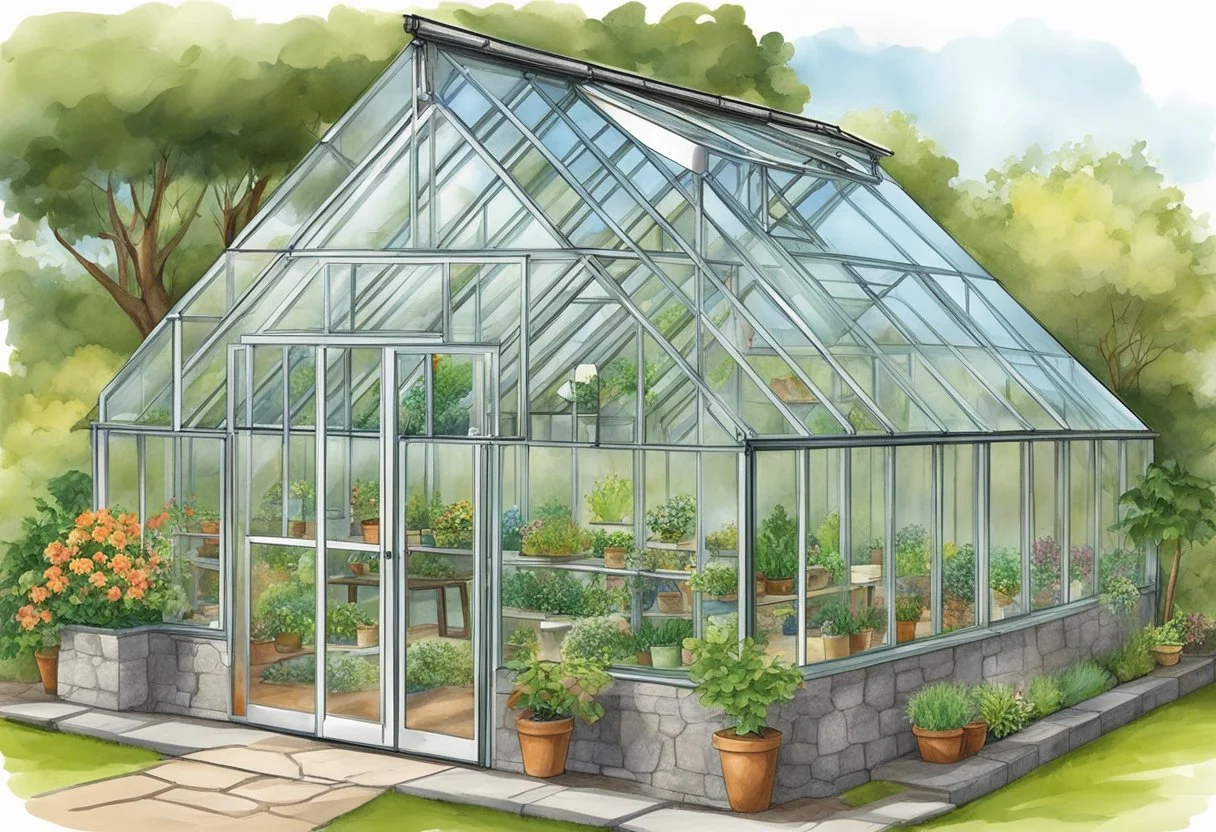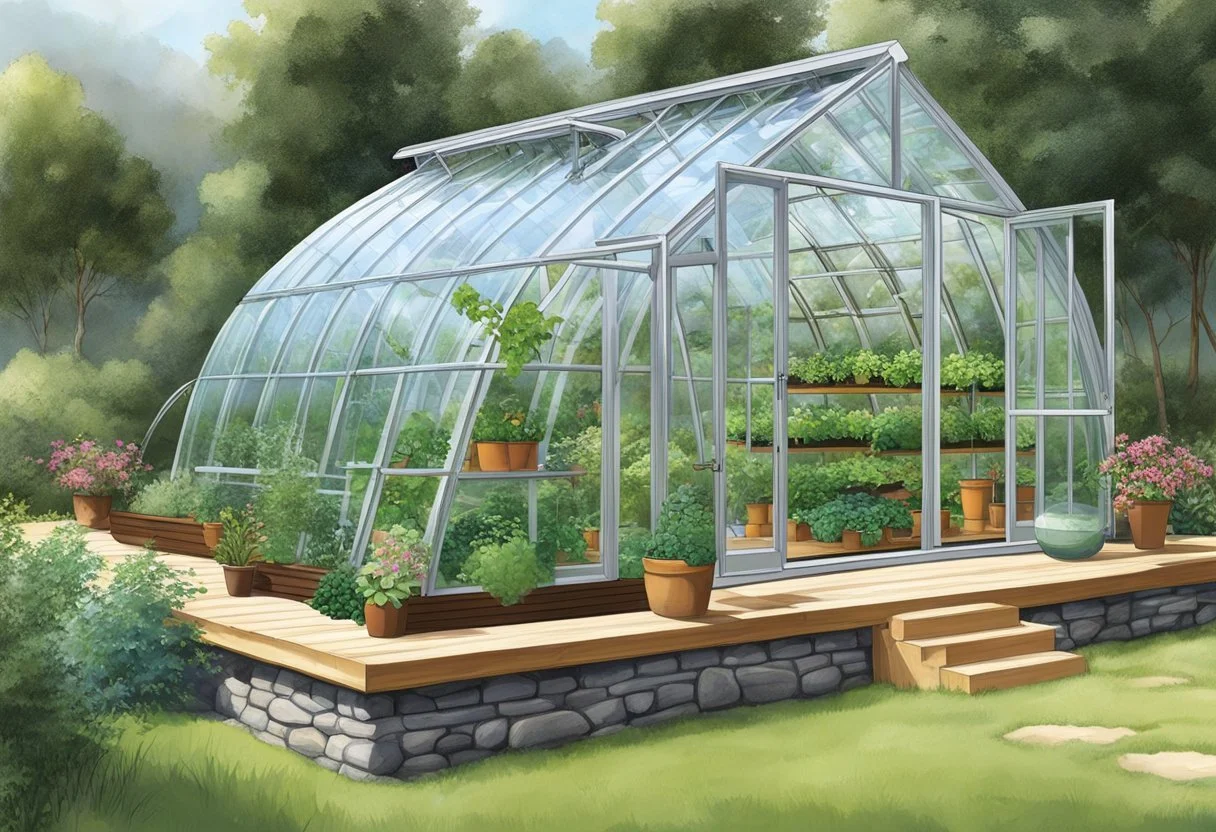How to Build an Earth-Sheltered Greenhouse?
A Step-by-Step Guide
This article is part of our series on Natural Health
Discover > Natural Health > How to Build an Earth-Sheltered Greenhouse?
Building an Earth-sheltered greenhouse can be a rewarding and sustainable way to provide a comfortable environment for plants while maintaining energy efficiency. This approach to greenhouse construction capitalizes on the natural insulation provided by the earth, resulting in a stable temperature throughout the year. As a result, it provides a range of benefits such as reduced energy consumption, a longer growing season, and protection from harsh weather conditions.
Earth-sheltered greenhouses come in various shapes and sizes, but they all share common principles centered around using the earth's mass to store and retain heat. By incorporating techniques such as passive solar design, thermal mass, and efficient materials into the building process, these greenhouses excel in both functionality and environmental sustainability.
This article will guide you through the necessary steps for designing and constructing an Earth-sheltered greenhouse. By following these guidelines, you'll be on your way to creating a sustainable and efficient space dedicated to nurturing your plants and providing an ideal environment for year-round gardening.
Need for an Earth-Sheltered Greenhouse
An earth-sheltered greenhouse is a valuable addition to any garden or property, especially in the northern and southern hemispheres where temperature fluctuations can significantly impact plant growth. By using the natural insulation provided by the Earth, an earth-sheltered greenhouse can maintain a stable temperature throughout the year, protecting plants from extreme weather conditions and improving overall growing conditions.
In the winter months, particularly in the northern hemisphere, the low angle of the sun makes it difficult for traditional greenhouses to receive adequate sunlight. An earth-sheltered greenhouse, however, has a unique design that allows it to capture the low-angle winter sun, optimizing light exposure and keeping the interior space warm. This not only reduces energy costs but also extends the growing season, allowing gardeners to cultivate a wider variety of plants.
Another significant advantage of an earth-sheltered greenhouse is its resilience to harsh weather conditions such as strong winds, heavy snow, and hail. Due to its partially buried design and sturdy construction, it can withstand extreme weather events, ensuring the safety of the plants inside. Additionally, the insulation provided by the Earth helps regulate humidity levels, reducing the risk of fungal growth and maintaining an optimal environment for the plants.
Apart from the practical benefits, an earth-sheltered greenhouse also has a reduced environmental footprint compared to a traditional greenhouse. The lower energy requirements and natural insulation lead to decreased CO2 emissions and overall energy consumption. This makes it an ideal choice for environmentally-conscious gardeners or those looking to reduce their carbon footprint.
In conclusion, an earth-sheltered greenhouse addresses the challenges faced by traditional greenhouses in both northern and southern hemispheres. It offers enhanced temperature control, improved light exposure, resilience against harsh weather conditions, and a more sustainable approach to greenhouse gardening.
Understanding the Basics of Earth-Sheltered Greenhouses
An earth-sheltered greenhouse utilizes the natural insulation and thermal mass of the earth to create an ideal environment for plants. Situated partially or fully underground, these greenhouses efficiently maintain consistent temperatures and maximize the use of sunlight.
The first key element of an earth-sheltered greenhouse is its underground design. Building the structure partially or fully below ground level allows for effective insulation and heat retention, as the earth's thermal mass naturally stabilizes the temperature. Additionally, the underground setting protects the greenhouse from harsh weather, reducing the risk of damage or heat loss.
The choice and use of materials play a crucial role in the performance of an earth-sheltered greenhouse. Glass and plastic, both commonly used for glazing, allow sunlight to penetrate while retaining heat. Plastic sheeting, such as polyethylene, polycarbonate, and acrylic, is lightweight and affordable, making it a popular choice among gardeners. Be sure to select the appropriate glazing material based on your specific needs, budget, and climate.
Insulation is essential in an earth-sheltered greenhouse to keep the warmth inside and prevent heat loss, especially during colder months. Insulating materials such as foam boards and straw bales can be used to effectively line the walls and roof of the greenhouse. Additionally, the floor of the structure should be insulated to maintain a consistent temperature and prevent the escape of heat into the ground below.
With an earth-sheltered design, capturing and utilizing sunlight is critical for plant growth. The orientation and placement of the greenhouse will determine how much sunlight it receives. Typically, a south-facing structure will maximize sun exposure, ensuring plants receive ample light throughout the day. Along with strategic placement, the inclusion of light-reflecting materials and adjustable shade mechanisms can provide further control over the sunlight entering the greenhouse.
In summary, an earth-sheltered greenhouse relies on the properties of the earth coupled with the careful selection and use of materials to create an optimal environment for plant growth. By understanding the basics of underground designs, glazing and insulation materials, and sunlight management, you can build a highly efficient and effective greenhouse that thrives in any climate.
Location and Design Considerations
When building an earth-sheltered greenhouse, selecting the right location and considering the design are crucial factors. The ideal location for an earth-sheltered greenhouse is a south-facing hill or south-facing slope, which ensures that the structure receives maximum sunlight throughout the day. This positioning helps maintain consistent indoor temperatures and promotes efficient plant growth.
Before setting the greenhouse's foundation, observe the natural drainage patterns on the chosen south-facing slope. Doing so helps avoid water accumulation issues and minimize the need for complex drainage systems. Remember, a well-draining area is essential for your plants' healthy growth and the overall structural integrity of the greenhouse.
When it comes to the design, the shape of an earth-sheltered greenhouse should be a rectangle. This layout offers multiple benefits, such as efficient use of space, ease of construction, and simplified temperature control. In addition, a rectangular design allows for a uniform distribution of sunlight, ensuring optimal light exposure for plants in every corner of the greenhouse.
A few essential design considerations include the type of glazing, insulation materials, and ventilation systems. Choose a highly energy-efficient glazing material, such as polycarbonate or double-pane glass, to retain maximum heat during colder months. Insulate the north-facing walls, floor, and roof of the greenhouse with adequate materials like extruded polystyrene or spray foam to minimize heat loss. Lastly, ensure the inclusion of a well-designed ventilation system to control humidity and maintain a proper airflow within the greenhouse.
Following these location and design guidelines can significantly contribute to the overall success and productivity of your earth-sheltered greenhouse. Providing a stable growing environment begins with careful planning, ensuring that plants receive the necessary nutrients, light, and protection from the elements.
Materials Required
When building an earth-sheltered greenhouse, it's essential to choose suitable materials that can withstand the environmental pressures and ensure longevity. Not only does this selection help create a sustainable and efficient greenhouse, but it also opens the possibility of using reclaimed and recycled materials.
One of the most popular choices for greenhouses is glass. A glass greenhouse allows maximum light penetration and provides excellent insulation. However, glass can be expensive and somewhat fragile. Moreover, large panes are challenging to transport and install without professional help.
Polyethylene sheeting is another suitable material. This type of plastic sheeting is cost-effective, easy to install, and provides good light transmission. However, it has a shorter lifespan than other materials, requiring replacement every few years. Double layer polyethylene sheeting can be inflated to provide additional insulation.
Fiberglass is a durable and lightweight option that can help withstand varied weather conditions. It offers decent light transmission and can be shaped into curved or gabled structures. The downside to fiberglass is that it can yellow over time, reducing light transmission and necessitating maintenance or replacement.
The foundation and structure of the greenhouse can benefit from cement blocks. Cement blocks provide a robust, long-lasting framework and can be readily sourced from recycled materials or locally made to reduce environmental impact. Additionally, they can easily support heavier greenhouse materials, such as glass.
Reclaimed and recycled materials can significantly reduce the overall cost of building an earth-sheltered greenhouse while promoting sustainability. For instance, using old windows or patio doors as glazing materials for the greenhouse can cut down on waste and reduce expenditures. Similarly, salvaging lumber, bricks, or metal roofing materials from demolished buildings can provide the needed elements for constructing a functional and affordable greenhouse.
In summary, there is a wide range of materials available for building an earth-sheltered greenhouse, each with its pros and cons. Careful consideration and selection based on factors like budget, sustainability, and the desired level of insulation will ensure a successful build and a thriving greenhouse ecosystem.
Construction Process
Excavating the Site
Before beginning the construction of an earth-sheltered greenhouse, carefully choose a location on your property. It should have good sun exposure and access to water. Begin by removing the topsoil and setting it aside for later use. Excavate the site to accommodate the greenhouse's desired size and shape. The depth of the excavation will vary depending on the surrounding insulation materials, like rammed earth or other earth berming techniques.
Building the Frame
The frame of your DIY greenhouse can be constructed using a variety of materials, such as PVC piping, wood, or even metal. The choice of material will depend on your budget and aesthetic preferences. First, install the vertical supports and secure them to the excavated site's base. Next, attach the horizontal beams to create the desired greenhouse shape. Be sure that your frame is sturdy and can bear the weight of both the covering and potential snow loads in the colder months.
Adding the Covering
There are several options for the greenhouse's covering, including glass, plastic sheeting, or fiberglass. Glass provides the best heat retention but is more expensive and fragile. Plastic sheeting is the most affordable option but can have shorter lifespans, whereas fiberglass provides a good balance between cost and durability. Wrap the chosen covering material around the greenhouse frame and secure it in place. The covering should be tight and well-sealed to prevent air leaks and ensure proper insulation.
Ensuring Proper Drainage
A well-functioning drainage system is essential for the health of your earth-sheltered greenhouse. Good drainage prevents excess water from accumulating in the growing area and protects your plants' root systems from rot. French drains are a popular option and can be installed around the perimeter of your greenhouse. To create a French drain, dig a trench surrounding the greenhouse, and insert gravel or crushed stone, along with a perforated pipe, to facilitate water flow away from the site. Lastly, replace the topsoil you set aside earlier, ensuring it slopes away from the greenhouse for optimum moisture management.
Importance of Ventilation and Insulation
Proper ventilation and insulation are crucial elements in the construction of an effective earth-sheltered greenhouse. They both ensure optimal growth conditions for plants and maintain a comfortable temperature and humidity level within the greenhouse.
A well-designed ventilation system ensures adequate air circulation, which reduces the risk of pests and diseases. It also helps maintain proper humidity levels, which is essential for plant growth and prevents excess condensation that can lead to mold or mildew. Passive and active ventilation options are available to suit different greenhouse designs and sizes. Passive options include vents and windows placed strategically, while active options involve fans and other air circulation devices.
Insulation plays a significant role in maintaining a consistent temperature within an earth-sheltered greenhouse. Properly insulating an earth-sheltered greenhouse ensures energy efficiency and cost savings. One effective insulation method used in greenhouses is the creation of an insulating airspace between layers, which can be achieved by using materials such as bubble wraps, polystyrene sheets, or rigid insulating panels.
Thermal mass is another consideration when insulating your greenhouse. Materials with high thermal mass can absorb and store heat, which can help regulate temperature fluctuations within the greenhouse. Examples include earth, water, concrete, and bricks.
To maximize the insulation and ventilation in your earth-sheltered greenhouse, it is essential to consider:
The location and orientation of the greenhouse, as this will affect both ventilation and insulation requirements
The appropriate combination of insulation materials and strategies, suitable for your local climate and greenhouse design
Regular maintenance of your ventilation system to ensure optimal functioning and energy efficiency
By incorporating effective ventilation and robust insulation methods, you can create an ideal environment for your plants, leading to a successful earth-sheltered greenhouse.
Cropping in an Earth-Sheltered Greenhouse
Growing crops in an earth-sheltered greenhouse has many advantages for growers, including a constant temperature and a protected environment for vegetables. In this type of greenhouse, the growing season can be extended, allowing for a more abundant harvest.
The earth-sheltered greenhouse replicates the ideal conditions in which most vegetables thrive. The stable temperature provided by the earth ensures that plants receive the necessary heat without facing temperature fluctuations. This is especially beneficial for heat-loving plants like tomatoes, peppers, and cucumbers.
Being protected from the elements, crops in an earth-sheltered greenhouse are less prone to pests and diseases. This reduces the need for chemical interventions, making it an eco-friendly option for growers. Additionally, the controlled environment allows growers to cultivate a diverse range of vegetables, even those that may not typically grow well in their region.
Planting in raised beds or using containers is a popular method in earth-sheltered greenhouses, as this improves drainage and prevents soil compaction. The space between the beds can also be used for growing smaller plants or herbs.
To efficiently utilize the space available within the greenhouse, growers can implement vertical growing systems. This not only increases the number of crops that can be grown but also saves valuable floor space. Trellises, netting, and hanging baskets are some solutions to facilitate vertical growth.
Regular maintenance is important for successful cropping in an earth-sheltered greenhouse. Monitoring temperature, humidity, light levels, and ventilation helps maintain a healthy environment for the plants. By taking advantage of the benefits offered by earth-sheltered greenhouses, growers can enjoy higher yields and a more sustainable gardening experience.
Maintenance and Care Tips
Maintaining an earth-sheltered greenhouse requires attention to several important aspects. By following these tips, you can ensure that your greenhouse remains an energy-efficient and thriving environment for your plants.
Pest Control: Regularly inspect your greenhouse for signs of pests. Implement preventative measures like proper ventilation and use of organic repellents to reduce the risk of infestation. Keep the surrounding areas clean and free of debris, as these might attract unwanted insects. If needed, use non-toxic chemicals judiciously to manage pests while preserving your plants' health and the environment.
Irrigation: An effective watering system is crucial in an earth-sheltered greenhouse. Choose an energy-efficient irrigation method, like drip irrigation, to minimize water waste and evenly distribute water to your plants. Ensure that the watering schedules are tailored to each plant's specific needs, and monitor the soil moisture regularly to prevent over- or under-watering.
Energy-efficient measures: To optimize the energy efficiency of your earth-sheltered greenhouse, implement some practical techniques. First, install insulating materials on the north-facing wall to reduce heat loss. Additionally, use energy-efficient lighting like LED or CFL bulbs, which consume less energy and emit less heat. Lastly, automate the greenhouse's climate control system to maintain ideal temperature and humidity levels without manual intervention.
By diligently following these maintenance and care tips, you will greatly enhance the performance and longevity of your earth-sheltered greenhouse, while protecting your plants and fostering their growth.
Case Studies and Examples
Mike Oehler has pioneered earth-sheltered greenhouse construction and gained recognition for his innovative designs. He developed the GROWHOLE, a subterranean greenhouse that has proved quite successful. Oehler’s concept leverages the natural insulation provided by the earth, resulting in a lower energy footprint and protection from extreme temperatures.
Mother Earth News, a popular resource for sustainability and eco-friendly living, showcases several examples of earth-sheltered greenhouses. They have published articles discussing various designs, materials, and construction techniques, providing a comprehensive understanding of the subject.
The Walipini concept originated in Latin America and has been promoted by the Benson Institute, an agricultural research organization. The design relies on the excavation of a rectangular pit and covering it with a transparent roof to allow sunlight in. The earth's thermal mass provides insulation, and the inclined roof captures solar radiation efficiently.
These case studies and examples demonstrate the diversity and adaptability of earth-sheltered greenhouses. Whether building a simple Walipini or a more complex GROWHOLE, the core principle remains constant - tapping into earth's natural insulation properties to create a more sustainable and efficient greenhouse.
Conclusion
Building an earth-sheltered greenhouse is a practical and sustainable solution for gardening enthusiasts and commercial growers alike. By harnessing solar energy, an earth-sheltered greenhouse creates a self-sustaining environment for plants to thrive in year-round. With decreased energy consumption and a reduced carbon footprint, this innovative approach to gardening offers a range of environmental benefits.
Construction of an earth-sheltered greenhouse requires careful planning and consideration, as well as the incorporation of essential features such as insulation, ventilation, and glazing. Ensuring the greenhouse has an optimal north-south orientation maximizes the efficiency of solar energy, keeping the space warm even during colder months.
Investing in a well-designed earth-sheltered greenhouse not only promotes ecological sustainability but also provides a rewarding and accessible gardening experience. By following expert guidance and best practices, both novices and experienced growers can enjoy bountiful harvests from their sustainable, energy-efficient greenhouses.
Natural Health Solutions for Personal Care and Wellness
Natural health practices can provide a range of benefits for personal care and wellness. Perfume is often made with synthetic fragrances that can be harmful to health. Choosing natural and organic perfumes made with essential oils can help to reduce exposure to harmful chemicals and promote overall health and wellness.
Homemade lip exfoliants can be made with natural ingredients like sugar, honey, and coconut oil to help remove dead skin cells and promote healthy, moisturized lips. These ingredients can be mixed together and gently rubbed onto the lips for a natural and effective solution.
Dark circles under the eyes can be caused by a range of factors, including liver health. A healthy liver can help to promote healthy blood flow and reduce the appearance of dark circles. Eating a healthy diet, staying hydrated, and reducing alcohol and caffeine intake can all help to promote liver health.
Body butter can be used to moisturize and nourish the skin. To use body butter, simply apply a small amount to the skin and gently massage in until fully absorbed. Body butter can be used on the hands, feet, and body for maximum benefit.
By incorporating natural health practices into your daily routine and making healthy choices for personal care and wellness, you can support your overall health and well-being in a sustainable and holistic way. It's important to do your own research and consult with a healthcare professional before using any new remedies or making significant changes to your diet or lifestyle.
#underground greenhouse #above ground greenhouse #passive solar energy #year round food production #solar year round system #thermal battery created #solar panels #earth sheltering






